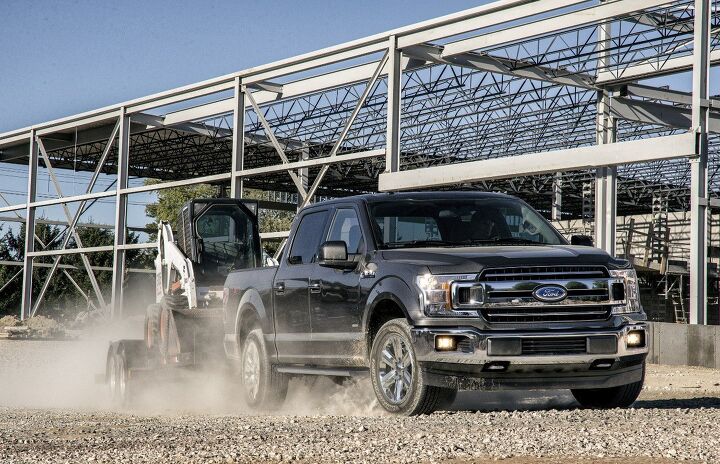Ford Announces Improved Hauling and Long Haul Economy for the 2018 F-150

As promised, Ford is updating the engine lineup in the company’s best-selling F-150 for the 2018 model year, providing improved fuel economy and maximum towing capacity across the board.
While it’s always a good idea to hold out a bit of skepticism until review time, Ford previously low-balled its economy estimates for the F-Series — as such, we’re working with some previously existing good faith.
News has been trickling out regarding Ford’s upcoming styling tweaks, advanced safety tech, and a powerful new diesel engine for the 2018 model. We also knew the F-150’s gas engines would be getting upgraded specs and, while some alterations are minor, there are a few big numbers worth disclosing.
And they have little to do with the 5.0-liter V8.
Ford’s V8-equipped pickup maintains its impressive 3,270-pound payload capacity, but advanced dual port and direct-injection technology add 10 more horsepower and an additional 13 lb-ft. of torque.
The 5.0-liter also gets modest improvements in economy for both rear- and four-wheel-drive variants. According to the manufacturer, four-wheel-drive V8s now average 16 miles per gallon city and 22 mpg highway, while rear-drive models manage one better in both areas. While only a single extra mile of range per gallon, it’s not terrible for a motor with 395 hp and 400 lb-ft of torque.
It’s a similar story with the V6s. Boasting a combined average improvement of 1 mpg apiece, the new base 3.3-liter yields 19 mpg city and 25 mpg highway; the 2.7-liter Ecoboost hits 20 mpg city and 26 mpg highway. Obviously those numbers shrink a bit when outfitted with four-wheel drive, but still represent an overall improvement from 2017.
The 2.7-liter also receives an uptick in torque, now generating 400 foot-pounds at 2,750 rpm. Meanwhile, the 3.3-liter represents an 8-horsepower, 12 lb-ft of torque improvement over the old naturally aspirated 3.5-liter. Total output is 290 hp and 265 lb-ft.
The upgraded economy rating is primarily down to auto start-stop and the expanded availability of Ford’s 10-speed SelectShift automatic transmission, which now appears on everything but the base model, including the all-new 3.0-liter V6 Power Stroke turbo diesel.
Sadly, the 3.5-liter Ecoboost V6 doesn’t benefit from any such economy improvements. But it does possess a new maximum tow rating of 13,200 pounds. Weirdly, Ford didn’t advertise this as a 1,000 pound increase in capacity, but that’s exactly what you’re getting. The 2017 model was specified as possessing a 12,200 max haul, which was already enough to bring the F-150 into comparable range of the 2017 Chevrolet Silverado 1500’s 12,500 pound limit (with the 6.2-liter EcoTec3 V8 and applicable package).
Now, the F-150’s tow rating bests every competitor, including Ford’s V8 F-150, and is the best you can expect from a pickup without optioning for a super duty.
[Images: Ford Motor Co.]

Consumer advocate tracking industry trends and regulations. Before joining TTAC, Matt spent a decade working for marketing and research firms based in NYC. Clients included several of the world’s largest automakers, global tire brands, and aftermarket part suppliers. Dissatisfied, he pivoted to writing about cars. Since then, he has become an ardent supporter of the right-to-repair movement, been interviewed about the automotive sector by national broadcasts, participated in a few amateur rallying events, and driven more rental cars than anyone ever should. Handy with a wrench, Matt grew up surrounded by Detroit auto workers and learned to drive by twelve. A contrarian, Matt claims to prefer understeer and motorcycles.
More by Matt Posky
Latest Car Reviews
Read moreLatest Product Reviews
Read moreRecent Comments
- Rrp138519787 If Jeep wanted to re-introduce the Wagoneer name, they just should have named the Grand Cherokee L the Wagoneer instead, and done a little bit more styling differentiation. They could have done a super deluxe version as the Grand Wagoneer. But all Wagoneers would have been the three row version as the primary product differentiation. And would cause less confusion for consumers overall.
- D The only people who have TDS, which I assume is Trump Derangement Syndrome, are the MAGOTS who have been brainwashed to love him. They Know Not What They Do.
- The Oracle The updated Model Y beat this copy to market.
- ToolGuy™ I respect what the seller is doing, but this vehicle is not for me. (Seller doesn't care, has two people lined up already.)
- SCE to AUX How well does the rear camera work in the rain and snow?




































Comments
Join the conversation
I have an immense hatred for auto start/stop function on about 99% of vehicles. Some, it's a noticeable delay between foot off brake and engine start to vehicle moving. My 2016 has it, and initially I was concerned, but honestly it's so fast that I can't really beat my foot to the gas over the motor starting. It doesn't bother me in day to day use. The only time I get annoyed is at maybe a drive-thru, where I'm inching forwards. It's only one button to hit to turn it off, so it's not hard. Some cars you can't, so I understand that frustration. It's going to be on almost all vehicles at some point, so get used to it.
Seems like waiting for the "dual port and direct-injection technology" is the thing to do instead of looking at 2017 F150's without it. I've been a bit leery of Ford's turbo motors, but these updates may change that. Did they change their water pump location in the V6's? That is the other change I'd like to see.